Numismatics can be defined as the study, collection and preservation of currency, which can be in the form of coins, medals, tokens, paper currency, or any other related object. Numismatics plays an important role in the study of ancient societies and their dynamics. The study of coinage can help understand social, political, and most importantly the economic history of a civilization.
Coinage as a concept is not just currency. Coinage is closely linked with tradition and culture. Without it being a tradition, there would be no guarantee, system, or continuity of coins in society. This tradition has lasted for thousands of years and is still in place.
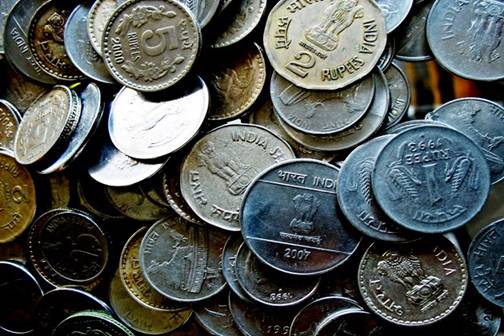
Figure 1: Coinage in today's day and age
Indian history has always been rich. Starting from the bronze age civilization of Indus valley to the medieval dynasties, leading on to the colonization of India- our subcontinent has always been subject to constant change and development. With multiple religions, cultures and kingdoms throughout its history, India has an abundance of rich archaeological sources to tell the tales of its past.
In reference to India and its rich history- the influence of religion, administration and wealth of the ones in power is reflected through the currency.
It is obvious that coinage did not just appear suddenly. Man did not have the need for exchange or payment of any kind as we were solely dependent on nature and its resources. With time, there was a change in the nature of human life. The onset of the Neolithic brought human settlements that were not mobile in nature. With the domestication of plants and animals, complex societies as well as larger populations – specialization in society appeared. This brought a wave of change and the barter system appeared.
While the transaction took place through exchanging goods for goods (or maybe other services), this system was tedious in nature as the value of items was subjective. By the Vedic period, the wealth of a person started being measured with a certain commodity such as a cow, animal skin, agricultural products such as seeds and plants, and mineral products, etc. With this, it becomes quite clear that coinage can be termed as the ‘remodelled’ version of the barter system.
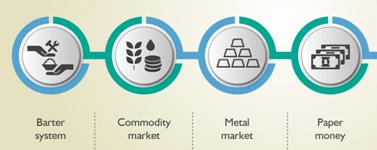
Figure 2 - barter system to modern-day currency
The question of what brought structure in the circulation of currency is still to be answered and understood. Before understanding that, we must trace the origin of coinage in the Indian subcontinent.
The origin of coinage in India as a topic is said to be controversial in nature. The dawn of coinage in India seems to be a tough question to answer. The theories postulated by numismatists do not help with the confusion either. The main drawbacks that we face while understanding the antiquity of coinage are the ambiguously written sources as well as unorganised methods of excavation in the past. It must be understood that these theories do not provide a clear-cut answer to the question- but sustain the knowledge that we already have on the subject. These can be divided into two main “theoretical streams”. While some believe that introduction to coinage was a result of foreign contact, the other dismisses this argument and propose the indigenous origin of coinage.
Understanding both the perspectives can be complicated in its own way and it seems to leave people puzzled. It must be noted that these theories do not overlap in any form and must be studied individually (if studied in depth).
Some of the foreign theories are the Greek, Babylonian and Achaemenid origin theories. As the names suggest, the scholars that postulated these suggested that the origin of coins in India took place under the influence of the following empires.
One example of this would be the theories postulated by H.H Wilson, who believed that there was no circulation of coins in India before the invasion of Alexander. Thus, they think that coinage may have been influenced by Graeco-Bactrians. These theories, unfortunately, were questioned as there is conclusive evidence of coinage appearing before Greek contact.
Indigenous origin theories are several in number as well. Scholars such as Dr. D.R. Bhandarkar, Edward Thomas, Alexander Cunningham, E.J. Rapson and many more put forward theories that explain the Indian origin of coinage. While these are under the same stream of thought, they run their own course in terms of ideology.
E.J. Rapson’s theory is a perfect example of understanding indigenous origin theories. One of the earliest advocates of the indigenous origin of Indian coinage, Rapson argues that metal started being exchanged as currency in the early Vedic period. He believes that this may have been the beginning of coinage in India. Rapson also supposes that the weight and appearance of the metal were taken into account while being used as a medium of exchange. He looks into ancient records such as Manu and Yajnavalkya Smritis to trace the production of coins in India.
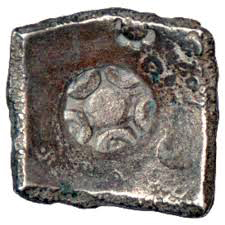
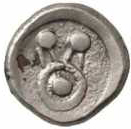
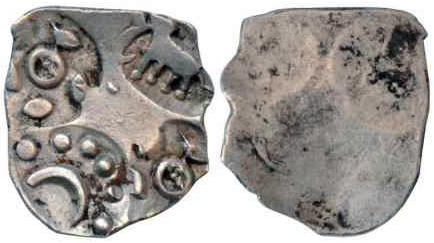

Some examples of Local and Imperial Silver Punch marked Coins
After going through several theories of origin, it is only natural for one to get curious about what archaeological evidence we have for the “first coin” that appeared on the Indian subcontinent.
Many academics argue that the first coins existed in the Vedic period- based on literary sources. Even though it seems probable, no physical evidence is found.
The first type of coins that appear on the Indian subcontinent is punch-marked. It is assumed that the manufacturing of the first punch-marked coins dates back to around 6th century BCE- by the Mahajanpadas. Found in the Indo-Gangetic plain (and later all around the Indian subcontinent), the date for its production is still debated. These punch-marked coins eventually develop from various localised types having one or two or four or more punches to a kind of uniform type having five punches and found over a very extensive area. These are made out of silver. E.J Rapson believes that the punch marks may have been different for each merchant – thus making them a symbol for authority. While the origin of coinage still remains a mystery, we know that a certain idea or tradition led India to have its first coins. We have more conclusive physical evidence for coins that appear later in time, which helps us understand many characteristics for the kingdoms to come. Through this, we can trace the history of our country through its coins and dig deeper into its past.
